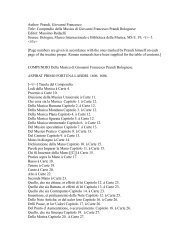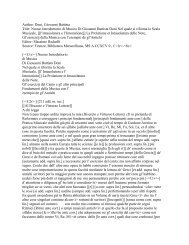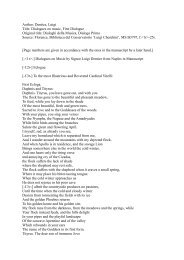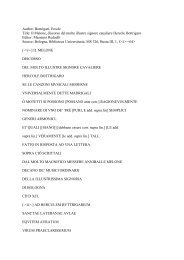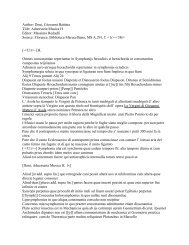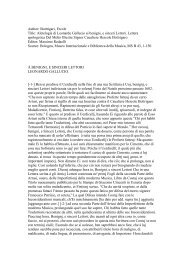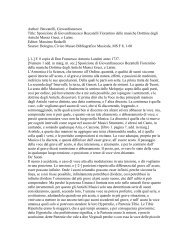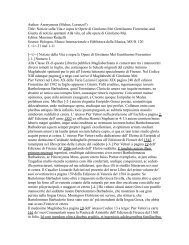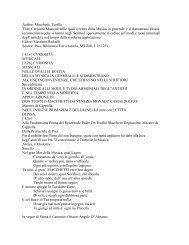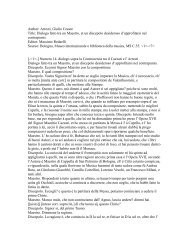Author: Doni, Giovanni Battista - manuscripts of italian music theory ...
Author: Doni, Giovanni Battista - manuscripts of italian music theory ...
Author: Doni, Giovanni Battista - manuscripts of italian music theory ...
You also want an ePaper? Increase the reach of your titles
YUMPU automatically turns print PDFs into web optimized ePapers that Google loves.
the middle ones. If this is agreed, said Tetrachrod becomes interposed between the<br />
one <strong>of</strong> the middle ones with the one <strong>of</strong> the disjointed ones, or, if this is excluded, the<br />
one <strong>of</strong> the disjointed ones takes its place. We must imagine that it proceeds in the first<br />
way when the system is widened up to the nineteenth note, filling five tetrachords and<br />
those two tones besides, and in the second way when it is removed and the System<br />
stays in its length <strong>of</strong> 15 notes and two octaves and it moves through the [sqb] square<br />
instead <strong>of</strong> the b round or flat: these are the two ways <strong>of</strong> the melodies [[remaining idle<br />
and]] because the one which they call 'according to nature' is nothing but a useless<br />
invention <strong>of</strong> [[<strong>of</strong> those]] people who with [[little week]] little or no foundation on<br />
sciences or liberal arts and with very little method dealt with musit at the time <strong>of</strong> our<br />
great-grandfathers. The most ancient <strong>of</strong> these Tetrachords, namely, [--] those<br />
that we must imagine that were used in the ancient lyre <strong>of</strong> seven or eight strings, are<br />
the two meddle ones, which correspond to the tenor voice and <strong>of</strong> the ideal man. The<br />
third in the sequence is the Hypaton and the last one the Hyperboleon. However,<br />
coming to the name <strong>of</strong> the notes, the first in order and last one in time is the one<br />
which is called Proslambanomenos by the ancients, which was also called<br />
[prosmelodos] by the Greeks. It was put into use so that the note Nete, which is the a<br />
la mi re might have a note corresponding to itself an octave lower, as it has one above,<br />
which is the aa la mi re [[said]]. Now, the reason why it is called in this way is clear<br />
and the authors reveal it to us, namely, because it is taken from outside to supplement<br />
and complete the consonances. Hence, said name means nothing else but sound or<br />
note which is taken as an extra addition over and above the rest. Therefore, although<br />
the ancient Romans called it Assumpta, [[,and wrongly so,]] it does not translate<br />
precisely, because it cannot be expressed with a Latin word, just as the word<br />
'Addition' cannot express it, and much less the word 'Acquired' which Zarlino uses<br />
between the two tetrachords. The low notes have these names. The first one is called<br />
Hypate Hypaton, namely The infima infimorum (since it seems more accurate to<br />
name them in this way according to their natural sequence which progresses from the<br />
low to the high register [--] than from the artificial one <strong>of</strong> the Instruments) and it<br />
is called in Italian the lowest <strong>of</strong> the low ones. The second is called Parhypate<br />
Hypaton, which means peninfima infimarum (the almost lowest <strong>of</strong> the low ones), the<br />
third one is called Lichanos Hypaton, or Index infimarum, and is called in this way<br />
from the index finger which was called [likhanos] by the Greeks, because it touched<br />
mostly that string in the ancient Lyre. The fourth one, which is also the first one <strong>of</strong> the<br />
second tetrachord, is called Hypate Meson, or Infima mediarom (lowest <strong>of</strong> the middle<br />
ones), the second one si called Parhypate Meson, or Peninfima mediarum (the almost<br />
lowest <strong>of</strong> the middle ones), the third one is called lichanos Meson or Index mediarum<br />
(index <strong>of</strong> the middle ones) and the fourth one simply Mese, or Mediana or middle<br />
one. Going forward, the first <strong>of</strong> the Diezeugmenon Tetrachord is called Parames,<br />
which means [[next to]] close to the middle one, and in Latin is called Penemedia,<br />
while in Italian we can also call it in this way to avoid saying almost middle one. The<br />
second one is called Trite diezeugmenon, or Tertia disiunctiarum (third <strong>of</strong> the<br />
disjointed ones) thus called because the Greeks started from the high register<br />
downwards. The trhid Paranete Diezeugmenon or Penultima Disiunctarum<br />
(penultimate <strong>of</strong> the disjointed). The fourth one is called nete diezeugmenon or Ultima<br />
disiunctarum (last <strong>of</strong> the disjointed). Now, the third Tetrachord proceds with the same<br />
names [--] because the first from the bottom [[is called]] is the same Nete<br />
diezeugmenon, since this tetrachord is united with the other one. The second one is<br />
called Trite Hyperboleon, which I call Tertia ultimarum (third <strong>of</strong> the last ones); the<br />
third one is called Paranete Hyperboleon or Penultima Ultimarum (penultimate <strong>of</strong> the



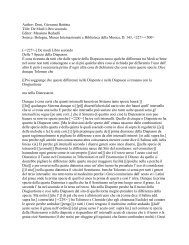
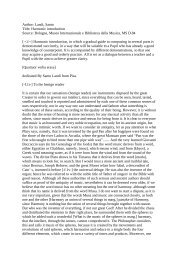
![Doni, Giovanni Battista Title: Trattato Dei Tuoni o [[Harmonie de]]](https://img.yumpu.com/45461005/1/190x245/doni-giovanni-battista-title-trattato-dei-tuoni-o-harmonie-de.jpg?quality=85)
